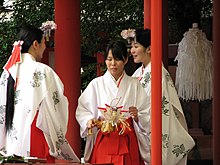Ikuta shrine

The Ikuta Shrine ( Japanese 生 田 神社 , Ikuta-jinja ) is a Shintō shrine in the Chūō-ku district (in the area of the former Ikuta-ku district) of Kobe , Japan and is probably one of the oldest shrines in the country.
history
According to the Nihonshoki , it was founded at the beginning of the 3rd century by the legendary Emperor Wife Jingū -kōgō in order to embed the Kami Waka-hiru-me . The shrine is also said to have served as a center for welcome ceremonies hosted by warriors returning home from recent attempts to invade Korea . Another kami of the shrine is Saruda-hiko , who is said to have been waiting for Prince Ninigi to arrive on earth at a crossroads and is said to have led him. He is worshiped in the Dai-kai-jinja (a side shrine ( massha )).
Around 806, at the behest of Emperor Heizei, 40 Kambe families were settled around the shrine to grow the sacrificial rice. The reading of the original name of the resulting "Kambe village" Kambe-mura is said to have been changed over time to Kobe-mura . The shrine is seen as the nucleus of today's city of Kobe.
During the Gempei War in the 12th century, parts of the Battle of Ichi-no-Tani took place in and around the shrine. Markings in the forest behind the shrine still bear witness to this, but most traces are no longer traceable due to the intensive development in the urban area of Kobe.
Until the Meiji Restoration , the priesthood in the shrine was hereditary.
Location
Originally built on Mount Isago , east of the Nunobiki Waterfall ( 布 引 の 滝 , nunobiki no taki ), it had to give way to the Ryūshō-ji Monastery during the first phase of the ascent of Buddhism in Japan and was relocated to the foot of Mount Isago in 690 . During a flood of the Nunobiki River in the 8th century, the shrine was badly damaged by fallen pine trees. So it was moved again, this time to a forest on the west side of the river, where it stands today. The planting of pines was banned; instead, there are now particularly powerful camphor trees in the area around the shrine.
Festivals
Actually applies Waka hiru-me as one of Amaterasu's younger sisters, here it is but when nigi- Mitama revered by Amaterasu. Because especially the Ikuta- reminds matsuri on April 14, at which the great flood is thought that the Nunobiki Waterfall of the pines had washed away the shrine, from which it concluded that Amaterasu did not like pines. This gave rise to a local custom whereby parishioners no longer hang pine branches on their homes for the New Year , as is traditional in the rest of Japan. Currently, two Nō plays , Ebira and Ikuta Atsumori , are performed near the shrine annually during the Ikuta ( akimatsuri ) Autumn Festival . Parts of the Genpei War are retold in them.
Individual evidence
- ^ Otto Refardt: "The Germans in Kobe (Alt-Kobe)", in: Communications of the German Society for Nature and Ethnology of East Asia , Vol. 39, Part A, 1956, p. 18
- ↑ Otto Refardt: "The Germans in Kobe (Alt-Kobe)", in: Communications of the German Society for Nature and Ethnology of East Asia , Vol. 39, Part A, 1956, pp. 17-18
Web links
- Official website of the Ikuta Shrine - Japanese
- Information offered by the tourism website of the city of Kobe - English
Coordinates: 34 ° 41 ′ 42.3 " N , 135 ° 11 ′ 26.2" E

